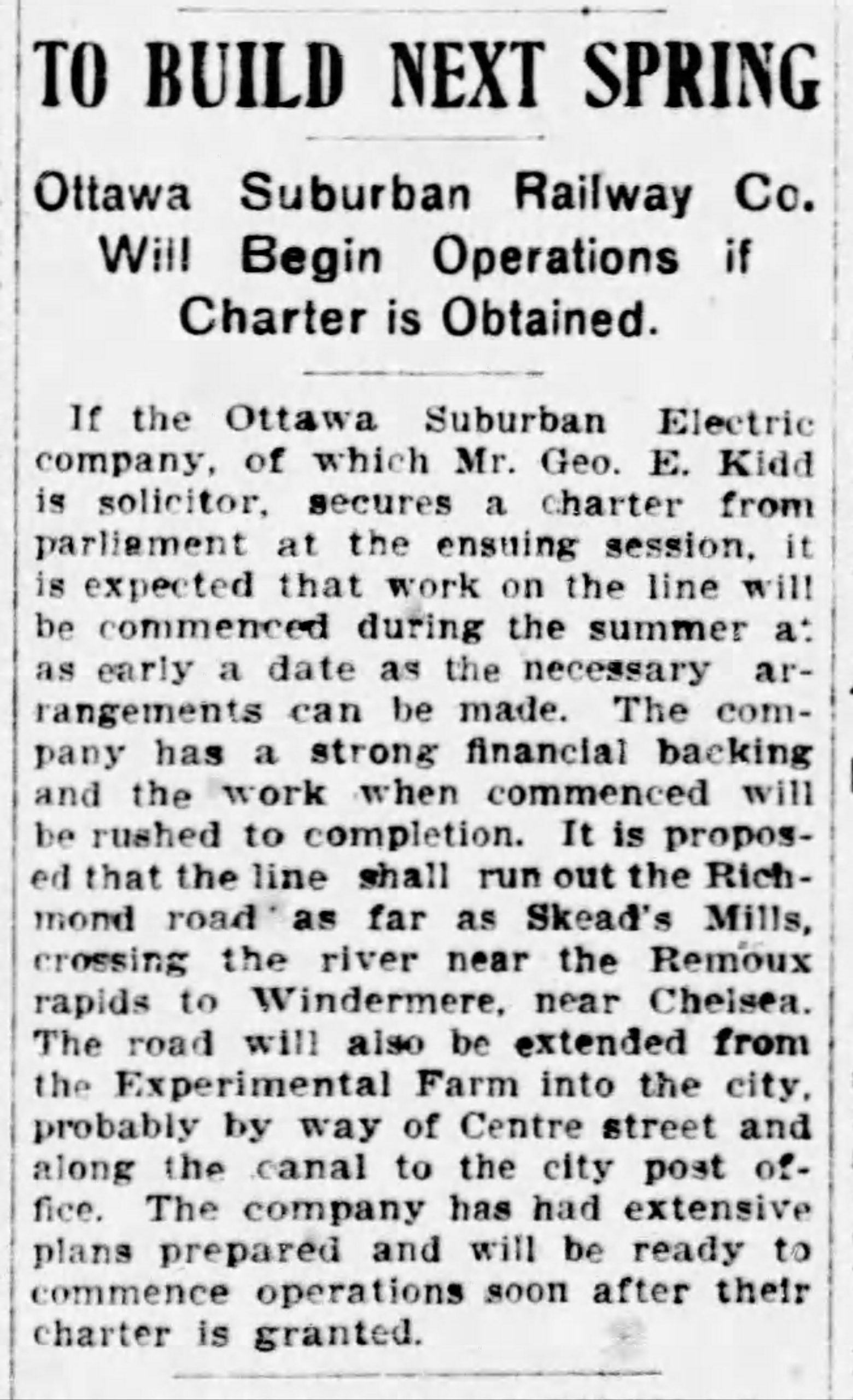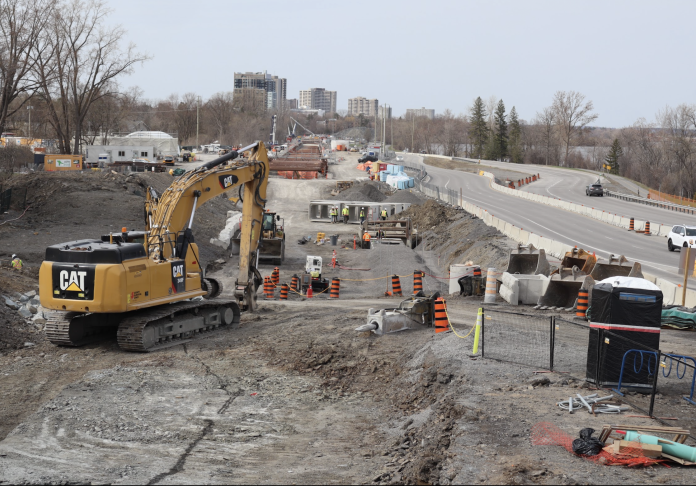By Dave Allston
In the late 19th century, most of Kitchissippi was not yet within the City of Ottawa. Future neighbourhoods such as Hintonburg, Wellington Village, Westboro and McKellar Park were sprawling farms, with a few houses along Richmond Road.
In 1891, the Ottawa Electric Railway (OER) had begun laying tracks throughout central Ottawa, creating a speedy and fashionable way to move around town, first from LeBreton Flats, then westward. Growth generated a chicken and egg scenario; rail directors said suburban neighbourhoods needed to be built up first before streetcars would arrive; but few residents were willing to move into sparsely populated areas with no infrastructure.
So In 1895, members of the OER formed what would be a short-lived sister corporation, the Ottawa and Aylmer Railway and Bridge Company. They were to build an electric line through Nepean out to Britannia, a bridge over the Ottawa River, and extended lines on the Quebec side to Hull, Aylmer and Fort Coulonge. These plans were largely theoretical, and the OER was mainly interested in retaining its exclusive rights to build a line. This was understandable, as the OER owned lots of land west of Hintonburg, through which those streetcars would eventually run.
Several times, the railway announced that construction on the line to Britannia was imminent. It finished track as far as Holland Avenue in 1896, and later that year placed 12,000 railway ties along the route to Britannia. They shared plans of a steamer that would ferry streetcar travellers from Britannia across to Aylmer. But no track was laid.
By late 1898, west end residents had heard plenty and seen little. Some of the wealthiest, including Frederick A. Heney, Robert H. Cowley, and George C. Holland formed the Ottawa Suburban Railway and Bridge Company (the “bridge” part was soon dropped), which declared a capital stock value of a million dollars.
The new company announced it was tired of the OER’s hollow promises, and shared its plans for a streetcar line alongside Richmond Road to Britannia, and then along the Ottawa River shore to Fitzroy Harbour. Along the route, at most likely the Remic Rapids (though Britannia was also an option), it planned a bridge to Gatineau, and an electric line to Kingsmere, Chelsea and Meech Lake. There would also be a branch to Hog’s Back which would continue along the east side of the canal into downtown where a station would be built behind City Hall on Elgin Street. This plan amounted to 50 miles of tram lines, and its wealthy investors had no need to borrow money.
In January of 1899, George E. Kidd, a Westboro land owner and a member of the OSRC, began a public relations campaign, speaking to officials and local residents (at the same meeting where they changed the neighbourhood’s name from Skead’s Mills to Westboro).
The vast majority of west end residents were optimistic that trains would soon be coming. They were also happy that Suburban promised cheaper fares (OER planned a fare of 10 cents, an expensive rate for the era), and had promised to keep tracks cleared in winter (a heavy snowstorm the previous winter left Hintonburg marooned for weeks).
A month later in February 1899, the Ottawa Board of Trade heard a plan to promote Ottawa Valley water power internationally. A company such as Suburban would play a key role in this work, as electric trains could work the area – mountains and steep grade issues had prevented access by steam trains.
Ottawa Electric Railway fought all of the ideas and plans of the Ottawa Suburban Railway Company. It had pre-emptively submitted an updated bill to the House to build a streetcar extension from Hintonburg to Bell’s Corners. The bill said construction would begin within 18 months, and completion within three years. The OSRC argued that these were false promises of unfair exclusivity rights.

The OSRC bill went to the Commons committee on railways, canals and telegraph lines in June.
OER representatives argued that they had a 30-year exclusivity contract for the Ottawa streets, a conflict with any approval for the OSRC. And Suburban’s was a redundant request, as Parliament rarely gave two charters over the same territory.
The Minister of Railways and Canals, Hon. A.G. Blair, said the OER was pretentious in arguing that no other company should ever be allowed to operate in the City. Some MPs agreed: “Throw the gates open. You don’t want to fossilize by permitting no one in here but yourselves,” one said.
Blair agreed, arguing “there is absolutely no good reason for excluding the company” and stating that any good company with proper financial backing should be permitted to enter the city.
But after a vote granting the OSRC entrance to Ottawa and approval to run on OER tracks to reach a central point of the city, a reconsideration motion was granted and debate stretched into a second lengthy session. It became clear that the OSRC would not get the rights it needed.
Future prime minister and former minister of railways Sir Charles Tupper encouraged the committee to disallow the request to run lines in Quebec, citing the existence of two railway companies already. “It would only be embarrassing the railways already in operation to permit the chartering of another in addition.”
The Suburban company walked away with the wind out of its sails, most of its application rejected, and significant opposition to what was left of its charter. In August, the bill was withdrawn, and the OSRC was dead.
But Ottawa Electric was clearly startled by the scare, and immediately began work on the streetcar route to Britannia. It delivered rails all along the route in August, and construction began in September. Regular streetcar service began in May 1900.
Who knows how west end development may have been altered had the Ottawa Suburban Railway Company’s charter been approved back in 1899!
